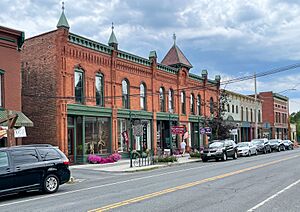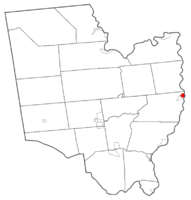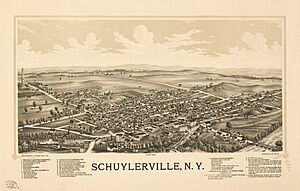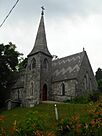Schuylerville, New York facts for kids
Quick facts for kids
Schuylerville
|
|
|---|---|
|
Village
|
|
| Village of Schuylerville | |

Bullard Block and Broad Street
|
|

Map highlighting Schuylerville's location within Saratoga County.
|
|
| Country | United States |
| State | New York |
| County | Saratoga |
| Named for | Schuyler family |
| Area | |
| • Total | 0.59 sq mi (1.52 km2) |
| • Land | 0.53 sq mi (1.38 km2) |
| • Water | 0.05 sq mi (0.14 km2) |
| Elevation | 128 ft (39 m) |
| Population
(2020)
|
|
| • Total | 1,370 |
| • Density | 2,570.36/sq mi (992.39/km2) |
| Time zone | UTC-5 (Eastern (EST)) |
| • Summer (DST) | UTC-4 (EDT) |
| ZIP code |
12871
|
| Area code(s) | 518 |
| FIPS code | 36-65750 |
| GNIS feature ID | 0964639 |
Schuylerville is a small village in Saratoga County, New York, United States. It is located in the northeastern part of the Town of Saratoga. The village is east of Saratoga Springs.
The Village of Victory is right next to Schuylerville to the southwest. The Hudson River forms the eastern edge of the village. In 2020, about 1,370 people lived here.
Schuylerville became an official village in 1831. It is named after the Schuyler family. This was an important family of Dutch background in early America.
This village is famous for a big event in American history. The British Army, led by General John Burgoyne, surrendered here after the Battles of Saratoga in 1777. These battles happened nearby in Stillwater.
Schuylerville has many old and important buildings. These include the General Schuyler House, which is part of the Saratoga National Historical Park. The Old Saratoga Reformed Church is also here.
The schools for the Schuylerville Central School District are in the village. The offices for the Town of Saratoga are also located here. The village has a public library, Fort Hardy Park, and a visitor center. It also has the Schuyler Hose Company volunteer fire department and several churches. The village government is run by a mayor and four trustees.
There are many fun places to visit nearby. These include the Saratoga Performing Arts Center and the Saratoga Race Course. The Saratoga National Historical Park is also close by.
Contents
History of Schuylerville
Early Settlements and Conflicts
Long ago, Native Americans lived in this area, even as late as 820 A.D. Later, in 1691, Dutch settlers from Albany moved here. They called the area Fort Saratoga. The important Schuyler family was among these early settlers.
Over time, different groups had conflicts. These included the French, Mohawk, Mohican, Dutch, and English peoples. After a peace agreement between France and England in 1763, more people could settle here. European Americans built homes and mills. General Phillip Schuyler built a flax mill in 1767. This was the first mill of its kind in the American colonies.
The community that grew near the fort was first called "Saratoga." However, the French and their Native allies partly destroyed it in 1745. This happened during King George's War. The Old Saratoga Reformed Church was started in 1770. It was used as a hospital during the Revolutionary War.
Schuylerville and the Revolutionary War
In 1777, the British Army, led by General Burgoyne, crossed the Hudson River. This was just north of Schuylerville, which was then known as Saratoga. They were on their way from Canada to Albany. Their goal was to split the American colonies in two and end the American Revolution.
The British marched south about nine miles to Bemis Heights. This is near today's Stillwater. American troops fought them in two Battles of Saratoga. The first battle was on September 19, and the second was on October 7, 1777. The American forces stopped the British advance. The British then went back north to a camp along Fish Creek, just outside the village. The Saratoga Battle Monument in the Village of Victory is near where the British camped.
American forces surrounded the British camp and stopped them from escaping. Winter was coming, and the British had no way out. So, they had to surrender. On October 17, 1777, General Burgoyne surrendered his army to American General Horatio Gates. This was a major turning point in the American Revolution. The British soldiers laid down their weapons in what is now Fort Hardy Park in Schuylerville. The American victory at Saratoga helped convince France to support the American cause. Spain also later joined in to help.
Historic Sites in Schuylerville

Several important buildings in Schuylerville are listed on the National Register of Historic Places. These include the Schuyler House, the Bullard Block, the Old Saratoga Reformed Church, and St. Stephen's Episcopal Church.
The Marshall House is also a very important Revolutionary War site. It is the only building left from the time of the Battles of Saratoga. The Prospect Hill Cemetery opened in 1865. It is next to the tall Saratoga Monument.
The Marshall House is about one mile north of the village center. It became famous because of a book by Baroness Frederika Riedesel. Her book was called Letters and Journals relating to the War of the American Revolution.
This house was built between 1770 and 1773. During the last days of the Battles of Saratoga, Baroness Riedesel stayed there. She was with her three young daughters, other British officers' wives, and wounded soldiers. She wrote about the difficulties they faced. She also shared her thoughts on the leaders of both the British and American armies. Some people call her the first woman war correspondent.
The Americans fired cannons at the Marshall House. They thought it was an enemy headquarters. Inside the house, you can still see cannonballs and other reminders of that difficult time. The stone cellar, which the baroness wrote about, looks much the same today. The Marshall House is the only building that still stands as a witness to the Battles of Saratoga. The owners welcome visitors if you make an appointment.
Geography of Schuylerville
Schuylerville covers about 0.6 square miles (1.52 square kilometers). Most of this area, about 0.5 square miles (1.38 square kilometers), is land. The rest, about 0.1 square miles (0.14 square kilometers), is water.
The village is located on the west bank of the Hudson River. The Hudson River forms the border with Washington County.
Major roads meet in Schuylerville. These include U.S. Route 4 and NY Route 29. NY Route 32 also joins with US-4 in the village.
Population and People of Schuylerville
In 2010, there were 1,386 people living in Schuylerville. There were 593 households and 356 families. The village had about 2,622.5 people per square mile.
Most of the people in the village were White (96.4%). About 1.2% were African American, and 0.9% were from other races. About 3.3% of the population were Hispanic or Latino.
In the households, 30.4% had children under 18 living with them. About 38.8% were married couples. Around 16.7% were single mothers. About 40% of households were not families.
About 32.7% of all households were single people. Around 11.8% had someone living alone who was 65 or older. The average household had 2.31 people. The average family had 2.91 people.
The population's age was spread out. About 25.1% were under 20. About 22.7% were 20 to 34. The median age was 37.1 years.
From 2009 to 2013, the average household income in the village was $55,284. The average family income was $67,768. About 7.8% of families and 12% of the total population lived below the poverty line. This included 14.4% of those under 18 and 18.9% of those 65 or older.
Environmental Topics in Schuylerville
Since the late 1900s, there has been a lot of discussion about cleaning up the Hudson River. The river borders the east side of Schuylerville. A company called General Electric (GE) used to dump chemicals called PCBs upstream. This happened in Hudson Falls from 1947 to 1977.
GE and the United States Environmental Protection Agency (EPA) agreed on a plan. GE is responsible for cleaning a 40-mile stretch of the river. The first part of this cleanup will end in Schuylerville.
In 2007, the EPA announced that the cleanup would not start until 2009. This was due to some project difficulties. The debate about cleaning the Hudson River caused some disagreement in the community for several years. Some residents were unsure if cleaning the river would make the problem better or worse. This cleanup project is said to be the largest Superfund project in the United States.
See also
 In Spanish: Schuylerville para niños
In Spanish: Schuylerville para niños





